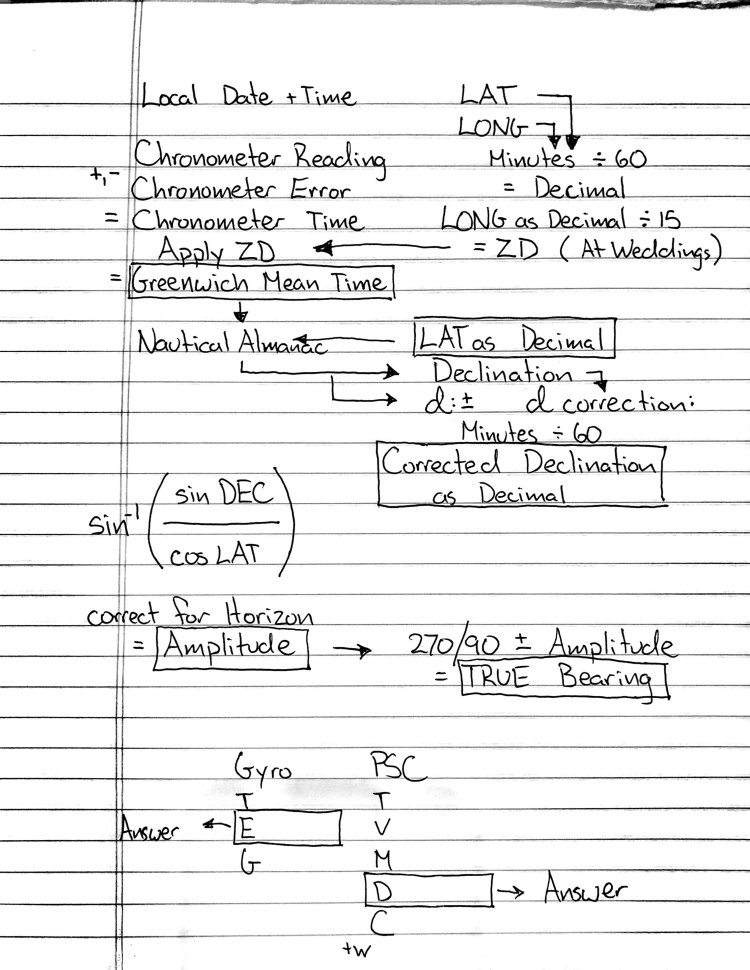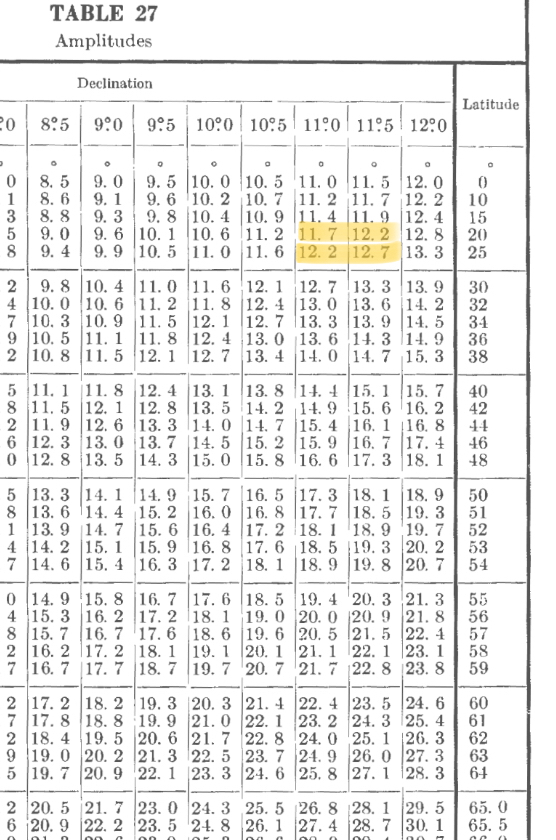USCG Exam solutions: Compass Error by Amplitude
There are two types of celestial problems in the near coastal exams for upper level licenses. They are both methods for correcting the compass. The logic for including these types of questions being that if you were out of sight of land, and needed to determine compass error, the only way to do so without fixed points of reference on shore, is by celestial sight. That is why these celestial questions are included on a near coastal exam.
A little disclaimer – The method I am going to show you here is not the true and correct way to solve for amplitude.
It is a little bit simpler and will give you the correct answer on the exams. If you should ever find yourself a hundred miles from shore and realize you haven’t had an accurate way to find direction this whole trip, you’ve got bigger problems than the descrepancy in this method. The truth is, the exam room is the only place you will ever need this, so let’s keep it simple, but know it is slightly different. I will elaborate where the difference is when we get to that part.
On to the meat and potatoes of Amplitude.
The sun rises in the east and sets in the west, this we all know. The sun rises and sets on different parts of the horizon from season to season and depending on our latitude, in a very steady and predictable way. Elementary stuff right? No need to get into all the fancy celestial angles and nomenclature, that is all you need to know to understand amplitude. We are going to compare where the sun rises or sets in comparison to due East or West. The difference between where it rose or set and due East or West is the amplitude. We will just look up what that should be using the Nautical Almanac and compare with what the problem has given us. The difference, is our compass error. Whew, not that scary right?
Get organized
Probably the hardest part of solving for the amplitude is organizing all of the information in the same way each time. Doing so will help you move through the data in the same pattern and make remembering the steps easier. Here is how I like to organize my scratch paper for solving amplitude, feel free to change this however you like, but remember the key is setting up the information the same way consistently. If that all looks confusing, dont worry, we will walk through a sample problem next.

Get your resources together
- Bowditch Volume II – You need this to look up the correction for the visible horizon
- Nautical Almanac
- Calculator
- Scratch paper
Sample Problem
We will solve an actual coast guard exam question together in the next video but here is that question in writing if you would like to follow along.
#01651 – On 23 October 1981, in DR position LAT 21° 13.0′ N, LONG 152° 18.0′ E, you observe an amplitude of the Sun. The Sun’s center is on the visible horizon and bears 259° PSC. The Chronometer reads 07h 21m 46s and is 01m 32s slow. Variation in the area is 5° E. What is the deviation of the magnetic compass?
- A- 0.9° E
- B- 1.5° W
- C- 5.9° W
- D- 6.5° E
The Video where we put it all together
The proper method
The proper calculation which I mention at the end of the video simply adds in the altitude of the observation. For shipboard obervations, the computed altitude of the visible horizon is -0.7°. Because we include the altitude, we don’t have to adjust for the visible horizon after this formula, the adjustment is in the altitude.

Bowditch method

Above you can see the applicable page of the green bowditch volume II. Here we must interpolate between the four highlighted numbers, as our actual arguments are between the arguments listed. We could say that our declination of 11.43 is 86% of the way between 11.0 and 11.5. Our Latitude is 21.21 which is 24.2% of the way between 20 and 25. Since the spread is 0.5 in both axes, we would end up with a value of 12.251. We then correct that for the visible horizon for a final amplitude of 12.551 and…. You can see how complicated this method becomes.
That is how to solve for amplitude, the right way, the wrong way, and my way. I hope it helps anyone who is studying for their exams!

Love your blog Ben. As a hawsepiper holding an upper level license, I can appreciate the way you lay out problems. I sat for my original 3rd Mates Unlimited and my 2nd Mate without ever entering a class room, but it took months of cross referencing and reexamining the way the USCG laid out the problems. I sailed deep sea then, so I had a lot of study time with mates to show me stuff. Keep on blogging! Tim Voss
Sent from Mail for Windows 10
LikeLike
There’s a couple errors in this.
1) GMT is actually 07:23:18 10/23/81. Chronometer is set to GMT, we just don’t know if its AM or PM. Our ZD is -10 hrs, but since we’re going from chronometer/gmt to zone time we add it. So we add 10 hrs to to 07:23:18 to get a zone time of 17:23:18 10/23/81 which corresponds with sunset. Using this time instead will give you an amplitude of W12.3S or 257.8°
2) Correction of Amplitude as Observed on the visible horizon. As it states in Bowditch Table 28, “for the sun, a planet, or a star, apply the correction to the OBSERVED AMPLITUDE in the direction away from the elevated pole.” The observed amplitude is 259° PSC as stated in the question. The elevated pole is the pole closest to us, the North pole in this case. So we subtract 0.3 from 259° giving us a PSC of 258.7°. If we use 257.8° as our True and 258.7° as our PSC in the TVMDC, our deviation will be 5.9°W.
Alternatively, Bowditch article 720 states “If preferred, the correction can be applied with reversed sign to the value taken from table 27 and compared with the uncorrected observed value.” So in that case we add 0.3 to to 257.8 = Amplitude 258.1°. With 258.1° as True and PSC 259; Use these values in the TVMDC equation and deviation equals the same, 5.9 W.
You do not always add the correction to visible horizon in amplitude problems. It depends on what hemisphere you’re in, and which formula you’re using.
LikeLike